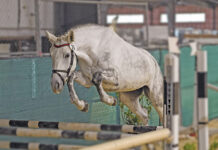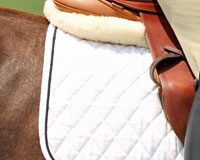
Q: My 8-year-old gelding has only been ridden in a hackamore. I’d like to start dressage with him, so he needs to wear a bit. I’ve tried every kind of snaffle and he seems to hate them all. He refuses to move forward, ignores my aids, and is just generally rebellious. How do I get him to accept a bit?
In order to truly work well in a hackamore your horse must already know how to flex at the poll when you take up more rein contact. I’m assuming he also stretches his neck and relaxes when you lighten your contact by lengthening the reins. Plus, in order to turn and circle in a hackamore he surely moves laterally (side to side) in response to your leg pressure. All of that works in your favor. What’s lacking is the subtlety of communication between horse and rider that’s the hallmark of dressage. You need a bit for that, and your horse hasn’t a clue what one is or how it functions. That’s why he won’t move forward and acts up in a bridle. He’s suddenly got a piece of steel in his mouth and he’s afraid of it.
Up until now, a hackamore has directed your horse by applying pressure to the bridge of his nose and his jaw. Soon a bit will direct him by applying pressure to the bars and corners of his mouth, and to some extent also his tongue and the roof of his mouth (the palate). Although your gelding is mature, you need to treat him like he’s a young, green colt. He needs a formal introduction to the bit.
Choose an inexpensive, well-worn leather headstall without any reins and a mild, loose-ring snaffle. Allow your horse to wear his baby bridle while he’s in his stall (under supervision) and under his halter while you groom him. Do not attach the lead rope to the bit rings and don’t try to ride him in the bridle yet. He needs to get used to the feel of a bit in his mouth.
Eventually you can attach a set of long lines (a pair of longe lines work well) to the bit rings and ground drive him a little, just enough so he comprehends the meaning of direct rein aids for turning and stopping. Once he consistently bends his neck and follows a direct rein, you can start riding him again. Just be sure to treat him like a green horse. If you suddenly start taking up rein contact and asking for collection he’ll suck back from the bit and possibly rear. Work more on creating energy and sending him forward on light contact at the working trot and then the canter. Use your leg aids to push him around his turns and circles rather than relying primarily on the bit. If he flips his head, gets behind the bit or continues to balk, seek some professional guidance. With time and patience, and perhaps a little mentoring from your instructor, he should transition nicely to a bit, and you’ll be back on track to your dressage dream.
–Cindy Hale
Ask your questions on the HorseChannel.com Forums >>
See more Expert Q&As >>
Submit your Ask the Expert question >>






All good suggestions. I also agree that this horse must already be responsive to leg aids, so that’s a plus for you.
It pains me to see that most bridles these days are sold with flash nosebands. This is to keep the horse from opening his mouth, which is his way of giving feedback, that he is not understanding, or is in pain. The best new infomation today on teaching a horse to accept the bit naturally, without strapping their mouths shut, is Linda Parelli’s ‘The Game of Contact’ DVD. Walter Zetl, says, she has explained the unexplainable, and I agree. This is a must have DVD for experts as well, to show you how to teach students via simulations on what contact is, and how to get the horse to also understand it. For more info go to http://www.parellinaturalhorsetraining.com
Thanks